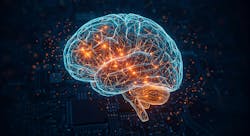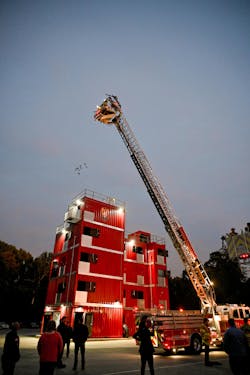Key Takeaways
- AI can reduce training officers’ workload, enhance the quality of their outputs and reclaim valuable time for them.
- The use of AI platforms that provide the capability to create targeted knowledge banks—rather than draw from the internet—ensures that all of the content that’s generated aligns perfectly with regulatory requirements and training standards that are particular to fire department training.
- The BoodleBox platform enables the creation of podcasts, which considers fire department cadets who prefer to listen rather than read.
I first ventured into the world of artificial intelligence (AI) around 2022 while I worked at the Amarillo College Regional Fire Academy (AC Fire Academy). Facing the challenges of rapidly integrating new curriculum, implementing innovative training approaches and processing information more efficiently, I found myself at a crossroads. Several colleagues suggested AI as a potential solution, but I hesitated, convinced that my limited technical expertise would be a barrier. Despite this initial reservation, I decided to take the plunge, and that decision fundamentally transformed my professional approach.
Reduced workload
For those who are unfamiliar with AI’s development trajectory, its practical applications date back to the 1950s and 60s, when the first systems that were capable of producing meaningful results emerged. After a period of relative dormancy, AI experienced a renaissance in the 1980s, steadily advancing until the explosive growth that we’ve witnessed in the 21st century.
Today’s AI landscape features sophisticated learning methodologies—supervised learning, unsupervised learning and reinforcement learning—that enable machines to acquire knowledge in unprecedented ways.
This technology now permeates our daily life, often operating invisibly in the background. When your email automatically filters spam, when your credit card company flags suspicious transactions and when your favorite game adjusts difficulty to match your skill level, you’re experiencing AI at work. These seemingly small conveniences represent remarkable technological achievements that quietly revolutionized our routines.
You might wonder how this relates to the pressing demands of a fire department training office, with protocol testing looming, training schedules to coordinate and countless other responsibilities demanding attention. The answer is straightforward: AI can reduce your workload dramatically, enhance the quality of your outputs and, most importantly, reclaim your valuable time.
Targeted knowledge banks
My journey began with relatively simple applications: compiling records, generating schedules and sorting data. Tasks that previously consumed hours or even days of meticulous spreadsheet work suddenly were completed in minutes through well-crafted AI prompts. This initial success encouraged me to explore more complex applications.
After experimenting with several AI platforms, I discovered BoodleBox, which has become my primary AI solution for educational and training applications. BoodleBox distinguishes itself through several key features that make it particularly valuable in academic and fire service environments.
BoodleBox’s capability to create targeted knowledge banks has proven invaluable. Unlike general AI systems that draw from the entire internet (often including outdated and/or incorrect information), BoodleBox allows me to upload specific documents—such as the academy textbook, Texas Commission on Fire Protection Curriculum Manual and my department’s standard operating procedures (SOPs)—and limit responses to only those trusted sources. This ensures that all generated content aligns perfectly with regulatory requirements and training standards.
The 2024 Texas Commission on Fire Protection Injury Report data, for instance, were uploaded to BoodleBox and used to create training scenarios that address the most common injury-causing activities. With my skills training accounting for 134 lost-time incidents in 2024, which resulted in 5,851 days missed (according to the Texas Commission on Fire Protection), having AI that can analyze these data and help to design safer training protocols is invaluable.
BoodleBox excels at processing various types of inputs—text, images, PDFs, spreadsheets—and at generating diverse outputs. This versatility allows me to upload photographs of our training tower, combine them with skills sheets and instructor availability data, and receive comprehensive training scenarios that maximize skill repetitions while minimizing downtime.
The platform’s collaborative capabilities enable multiple instructors to work within the same AI environment, sharing knowledge banks and building on each other’s prompts. This has fostered a culture of innovation within my department, where instructors regularly contribute to our collective AI resources.
Schedules and curriculum
One of my first major successes involved my department’s 16-week fire academy schedule. After inputting instructor availability dates and basic requirements, BoodleBox generated a comprehensive schedule within seconds, assigning appropriate numbers of instructors based on whether the day involved practical skills or lectures and ensuring equitable distribution of teaching responsibilities. What previously required two full days of manual coordination now happens almost instantaneously.
When our third-party academy testing vendor increased its annual fee to $25,000 from $5,000, we faced a significant budgetary challenge. Turning to BoodleBox, my department uploaded its textbook as a knowledge bank and generated testing questions that were drawn exclusively from this authorized material. These questions then were integrated into our college’s Learning Management System (Blackboard), creating a testing platform that rivals the previous solution at a fraction of the cost.
The quality of these AI-generated questions has been exceptional, and we now have complete control over the testing process, including the ability to make corrections, add reference information, such as textbook page numbers, and update content when materials change.
The time-intensive tasks of developing curriculum, updating materials and creating programs—from SOPs and protocols to administrative and public education presentations—have been streamlined through AI assistance. BoodleBox helps to review existing materials for potential conflicts, to update content based on new regulations and to create targeted presentations for specific demographics.
Strong test scores
To address the challenges of our hybrid fire academy model, particularly the absence of immediate instructor guidance when students encounter difficulties, I created an AI bot within Blackboard. This virtual assistant allows cadets to ask questions and receive accurate information instantly, which eliminates the time that they would otherwise spend searching for answers. This reclaimed time instead can be dedicated to studying and mastering essential material.
By limiting the bot’s knowledge base to our authorized resources (textbooks, Texas Commission on Fire Protection Curriculum Skills Manuals and other documents), we ensure that all responses align with regulatory requirements and approved training standards.
For some assignments, we encourage cadets to conduct open-ended research. For example, during public education projects, we allow them to use AI tools to fully explore and develop their ideas. Our main objective is to reduce the amount of time that’s spent on research, so cadets can focus more on developing their programs and deepening their learning. As a result, our state test scores are consistently above the statewide average. We believe that the increased exposure to course material, extra study time and hands-on experience—made possible by the time saved with AI—directly contribute to these strong results.
Podcasts
Recognizing that different learners respond to different formats, we expanded our use of BoodleBox to create podcasts that cover everything from protocol updates to policy changes. This audio-based approach provides an alternative learning pathway for those who prefer to listen rather than read, which allows personnel to absorb information during training sessions, workouts or commutes.
This has proven particularly valuable for cadets who miss classes because of illness. By converting lecture content into podcast format, these students can keep pace with their cohort despite their absence. Many cadets have reported that listening to material while driving or exercising enhanced their retention and understanding.
Training scenarios
As our academy faces record enrollment numbers this fall, we leveraged BoodleBox to optimize our field training approach. By inputting images of our training tower, skills requirements, instructor availability and cadet numbers, we generated integrated training scenarios that combine multiple skills into continuous evolutions. This approach minimizes downtime between activities and maximizes valuable repetitions of critical skills.
BoodleBox even helped us to develop new training props at a fraction of commercial costs. By uploading images of props that were observed at other training centers, we receive detailed materials lists and construction instructions, which enables us to build professional-quality training aids. This approach significantly extended our training budget while expanding our practical training capabilities.
More to come
The potential applications of AI in fire service education and training continue to expand. As BoodleBox and similar platforms evolve, we anticipate even more sophisticated capabilities, from virtual reality training simulations to predictive analytics that identify potential knowledge gaps before they manifest in the field.
The question isn’t whether AI can benefit your department; it’s how quickly you can implement it to start to realize its advantages. Every day without these tools represents lost efficiency, wasted resources and missed opportunities for innovation.
My journey with AI, particularly through the BoodleBox platform, transformed how we approach education and training at AC Fire Academy. By embracing these technologies, we enhanced the quality of our instruction, reduced administrative burdens and, most importantly, better prepared our cadets for the challenges that they’ll face in their career.
The fire service always has adapted to new technologies that improve effectiveness and safety. From the transition from horse-drawn to motorized apparatus to the adoption of thermal imaging cameras, our profession consistently has embraced innovation. AI represents the next frontier in this evolution: a powerful tool that, when properly implemented, can help us to fulfill our mission more effectively than ever before.
About the Author

Stephen Malley
Stephen S. Malley is the owner of MAI Public Safety Information Technology Group. The firm specializes in bringing AI solutions to public safety administration and focuses on workflow solutions and recruitment optimization. Malley currently serves as the coordinator for the Amarillo College Regional Fire Academy, where he manages program operations, ensures regulatory compliance and builds relationships with departments. Previously, he spent 17 years as department chair of public safety professions at Weatherford College, overseeing the fire, EMS and police academies and the fire, EMS and police degree programs. Malley’s career includes service with the Mansfield, TX, Fire Department, where he rose to the rank of captain-shift commander. He holds a Master of Public Administration in emergency management from Anna Maria College, a bachelor’s degree and multiple associate degrees in fire administration, EMS and criminal justice.


